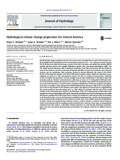Mostrar el registro sencillo del ítem
Hydrological climate change projections for Central America
| dc.creator | Hidalgo León, Hugo G. | |
| dc.creator | Amador Astúa, Jorge Alberto | |
| dc.creator | Alfaro Martínez, Eric J. | |
| dc.creator | Quesada, Beatriz | |
| dc.date.accessioned | 2015-04-14T21:03:25Z | |
| dc.date.available | 2015-04-14T21:03:25Z | |
| dc.date.issued | 2013-05-04 | |
| dc.identifier.citation | http://www.sciencedirect.com/science/article/pii/S0022169413003636 | |
| dc.identifier.uri | https://hdl.handle.net/10669/11383 | |
| dc.description | artículo científico -- Universidad de Costa Rica,Centro de Investigaciones Geofísicas. 2013. Este documento es privado debido a limitaciones de derechos de autor. | es_ES |
| dc.description.abstract | Runoff climate change projections for the 21st century were calculated from a suite of 30 General Circulation Model (GCM) simulations for the A1B emission scenario in a 0.5 0.5 grid over Central America. The GCM data were downscaled using a version of the Bias Correction and Spatial Downscaling (BCSD) method and then used in the Variable Infiltration Capacity (VIC) macroscale hydrological model. The VIC model showed calibration skill in Honduras, Nicaragua, Costa Rica and Panama, but the results for some of the northern countries (Guatemala, El Salvador and Belize) and for the Caribbean coast of Central America was not satisfactory. Bias correction showed to remove effectively the biases in the GCMs. Results of the projected climate in the 2050–2099 period showed median significant reductions in precipitation (as much as 5–10%) and runoff (as much as 10–30%) in northern Central America. Therefore in this sub-region the prevalence of severe drought may increase significantly in the future under this emissions scenario. Northern Central America could warm as much as 3 C during 2050–2099 and southern Central America could reach increases as much as 4 C during the same period. The projected dry pattern over Central America is consistent with a southward displacement of the Intertropical Convergence Zone (ITCZ). In addition, downscaling of the NCEP/NCAR Reanalysis data from 1948 to 2012 and posterior run in VIC, for two locations in the northern and southern sub-regions of Central America, suggested that the annual runoff has been decreasing since ca. 1980, which is consistent with the sign of the runoff changes of the GCM projections. However, the Reanalysis 1980–2012 drying trends are generally much stronger than the corresponding GCM trends. Among the possible reasons for that discrepancy are model deficiencies, amplification of the trends due to constructive interference with natural modes of variability in the Reanalysis data, errors in the Reanalysis (modeled) precipitation data, and that the drying signal is more pronounced than predicted by the emissions scenario used. A few studies show that extrapolations of future climate from paleoclimatic indicators project a wetter climate in northern Central America, which is inconsistent with the modeling results presented here. However, these types of extrapolations should be done with caution, as the future climate responds to an extra forcing mechanism (anthropogenic) that was not present prehistorically and therefore the response could also be different than in the past. | es_ES |
| dc.description.sponsorship | info:eu-repo/grantAgreement/Universidad de Costa Rica/Marine Science and Limnology Research Center (CIMAR)/808-A9-180/Costa Rica// | es_ES |
| dc.description.sponsorship | info:eu-repo/grantAgreement/Universidad de Costa Rica/Center for Geophysical Research (CIGEFI)/805-A8-606/Costa Rica// | es_ES |
| dc.description.sponsorship | info:eu-repo/grantAgreement/Universidad de Costa Rica/Center for Geophysical Research (CIGEFI)/805-A9-532/Costa Rica// | es_ES |
| dc.description.sponsorship | info:eu-repo/grantAgreement/Universidad de Costa Rica/Center for Geophysical Research (CIGEFI)/805-A9-224/Costa Rica// | es_ES |
| dc.description.sponsorship | info:eu-repo/grantAgreement/Florida Ice and Farm Company///Costa Rica// | es_ES |
| dc.description.sponsorship | info:eu-repo/grantAgreement/Panamerican Institute of Geography and History//GEOF.02.2011/// | es_ES |
| dc.language.iso | en_US | es_ES |
| dc.publisher | Journal of Hydrology 495: 94–112 | es_ES |
| dc.subject | Hydrometeorology | es_ES |
| dc.subject | Surface water hydrology | es_ES |
| dc.subject | Variable Infiltration Capacity Model | es_ES |
| dc.subject | Intertropical Convergence Zone (ITCZ) | es_ES |
| dc.subject | Mid-Summer Drought (MSD) | es_ES |
| dc.subject | Caribbean Low-Level Jet (CLLJ) | es_ES |
| dc.title | Hydrological climate change projections for Central America | es_ES |
| dc.type | artículo original | |
| dc.identifier.doi | 10.1016/j.jhydrol.2013.05.004 | |
| dc.description.procedence | UCR::Vicerrectoría de Investigación::Unidades de Investigación::Ciencias Básicas::Centro de Investigaciones Geofísicas (CIGEFI) | es_ES |
Ficheros en el ítem
Este ítem aparece en la(s) siguiente(s) colección(ones)
-
Meteorología [509]


